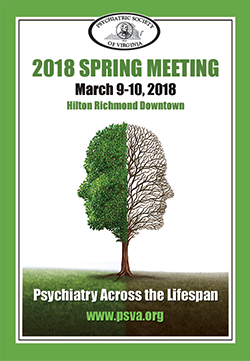Winter 2017 Issue |
|
In the News
When Selecting an Antipsychotic is Too Hard: Antipsychotic-induced Priapism
By Joshua Moran (VCOM DO Candidate 2018); Ryan Wade MD, MA; Stephanie Peglow DO, MPH
Prescribers must remain cognizant of the rare but significant risk of priapism with antipsychotic usage. As a urological emergency, priapism is a persistent and painful erection, unrelated to sexual stimulation that lasts longer than four hours. (1) Erections occur with parasympathetic-induced relaxation of the penis’ arterioles and smooth muscles, which increases blood flow into the corpora cavernosa. When engorged, the corpora cavernosa compress and restrict venous blood outflow. Priapism results from a functionally-aberrant imbalance between sympathetic and parasympathetic signaling; sympathetic-driven arteriole constriction and subsequent detumescence is hypoactive.(2) Priapisms can be non-ischemic (high-flow) or ischemic (low-flow). High-flow priapism is typically less common, painless, and lacks fibrotic damage. Low-flow priapism is painful and results from intracavernosal stasis. The majority of priapism cases result as an adverse effect of medications (primarily trazodone, antipsychotics, antihypertensives, or medications for erectile dysfunction). If left untreated, medication-induced priapisms (ischemic in nature) produce hypoxia, acidosis, and fibrotic damage.(3, 4)
Antipsychotic medications function primarily by antagonizing dopamine type 2 (D2) receptors (typical antipsychotics) or both D2 and 5-HT2A receptors (atypical antipsychotics). Antipsychotics also possess varying levels of anticholinergic, anti-noradrenergic, and antihistaminergic cross-reaction, which determine medication-specific side effect profiles. Meta-analysis revealed priapism occurring at a clinically significant higher odds ratio in antipsychotics that possess higher alpha-1 receptor affinities.(2) The study classified ziprasidone, risperidone, clozapine, and quetiapine as having high affinities for the alpha-1 receptor. These antipsychotics collectively held statistically higher odds of developing priapism than antipsychotics with low alpha-1 receptor affinity, such as olanzapine. One exception is aripiprazole (an antipsychotic with low alpha-1 receptor affinity), which revealed a high likelihood of developing priapism. Additionally, both quetiapine and olanzapine antagonize the alpha-2 receptors, which could exacerbate a priapism event through nitric-oxide like substance release.(2, 4, 5) In cases of recurrent priapism, later episodes often occur after an increasingly shorter duration of restarting an antipsychotic suggesting alpha-1 receptor sensitization may occur with repeated exposure to antipsychotics.(5)
Antipsychotic-induced priapism occurs more frequently when associated with underlying hyperviscosity syndromes (eg. sickle cell disease, malignancy) or diabetes.(1) Co-treatment with trazodone or antihypertensive medications that also exhibit alpha-1 antagonism elevates the risk of priapism. Having a history of prolonged erections may predispose men to medication-induced priapism.(6) No apparent relationship exists between antipsychotic dosage, treatment duration, and the likelihood of developing priapism.(5)
In assessing priapism, delay in treatment results in worsened morbidity.(6) Medication-induced, ischemic priapism may result in fibrosis and long-term erectile dysfunction, even if the priapism is treated surgically.(2) Rates of permanent impotence range between 40-50% for each priapism episode.(7) Finally, priapism may result in urinary retention, and if not treated promptly, even gangrene.(4)
It’s important for psychiatrists to remain vigilant for priapism as it may occur after a single dosage of antipsychotic or abruptly after a few years of uneventful antipsychotic usage.(8) When pertinent, include the risk of priapism in informed consent as well as need for emergency treatment. Consider continuing to remind patients of the risk with long term use.
References:
- Saghafi O, Koa A, and Druck J. “Recurrent priapism from therapeutic quetiapine.” West J Emerg Med. 15.1 (2014): 114-116.
- Andersohn F, Schmedt N, Weinmann S, et al. “Priapism Associated with Antipsychotics: Role of α1 Adrenoceptor Affinity”. J Clinic Psychophamacol. 30.1 (2010): 68-71.
- Compton MT and Miller AH. “Priapism Associated with Conventional and Atypical Antipsychotic Medications: A Review”. J Clin Psychiatry. 62.5 (2001): 362-366.
- Sood S, James W, and Bailon MJ. “Priapism associated with atypical antipsychotic medications: a review.” Int Clinc Psychopharmacol. 23.1 (2008): 9-17.
- Sinkeviciute I, Kroken RA, Johnsen E. “Priapism in Antipsychotic Drug Use: A Rare but Important Side Effect.” Case Rep Psychiatry. (2012): np.
- Thompson JW, Ware MR, and Bashfield RK. “Psychotropic medication and priapism: a comprehensive review.” J Clin Psychiatry. 51.10 (1990): 430-433.
- Penaskovic KM, Haq F, and Raza S. “Priapism During Treatment with Olanzapine, Quetiapine, and Risperidone in a Patient With Schizophrenia: A Case Report.” J Clin Psychiatry. 12.5 (2010): np.
- Tsai AC. “A Case of Recurrent Priapism in the Context of Quetiapine Use, Discontinuation, and Rechallenge.” J Clin Psychopharmacol. 31.2 (2011): 235-236.
YOUR NEWSLETTER IS NOW AVAILABLE ON YOUR SMARTPHONE AND TABLET!
JOIN PSV TODAY!
REGISTER TODAY!
PSV 2018
SPRING MEETING
March 9-10, 2018
Hilton Richmond Downtown
Richmond, Virginia
APA Find a Psychiatrist
Are you accepting new patients?
Opt into APA’s “Find A Psychiatrist” database. To view the functionality or opt-in, CLICK HERE
FYI: A link for this option has been added to the PSV website so the public can find you when they are looking for help.







